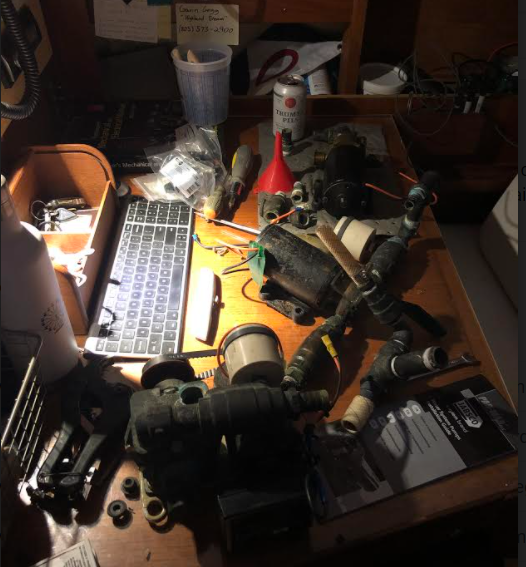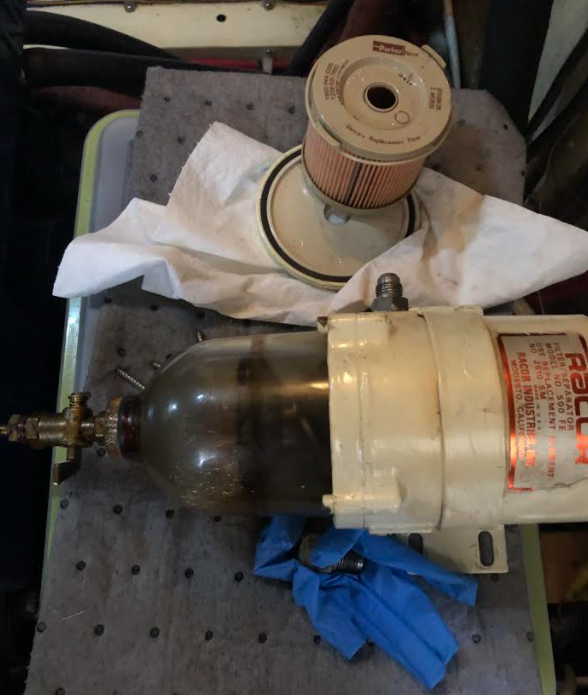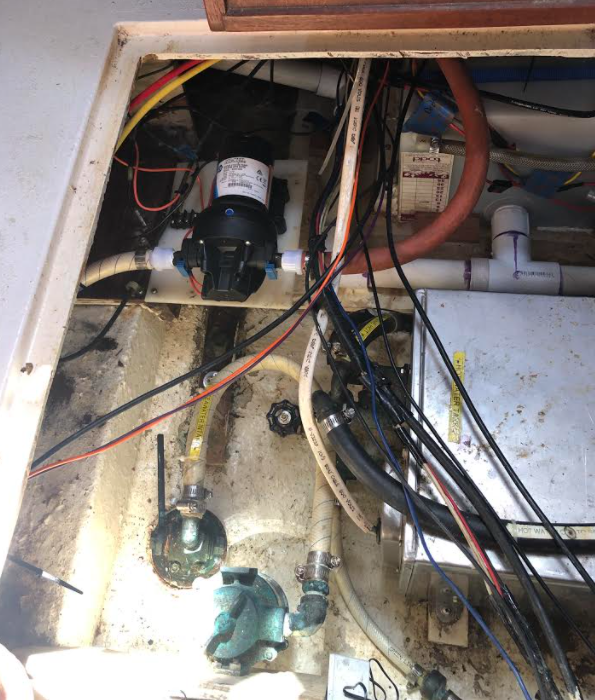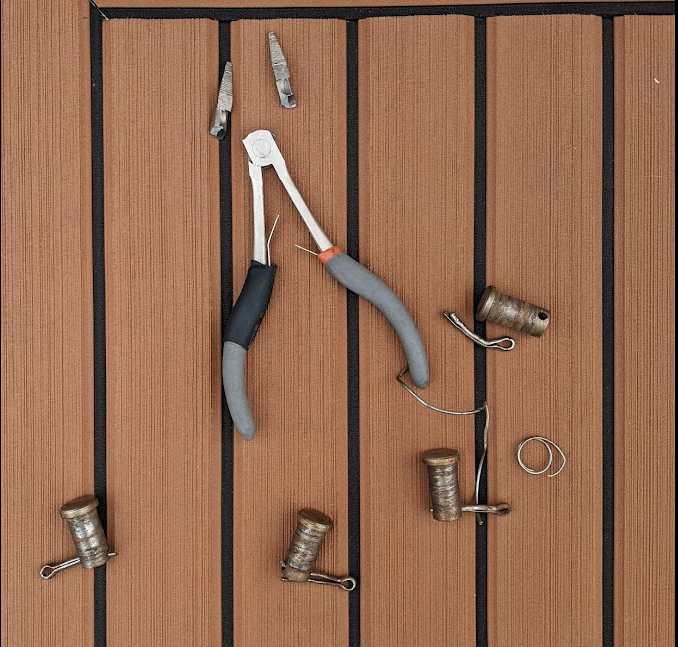Sailing Te Ara Update: Pumps, Pumps and more Pumps
- gcgegg91
- Jun 23, 2021
- 5 min read

Where to begin?! This was such a jam packed week its hard to describe what we did first. I was basically living in the hatch under the companion way or in the engine room testing, removing, swapping or repairing parts of the fuel transfer and fresh water systems. I spent most of the evenings covered in diesel, salt water, fresh water, or grey water. Sounds hard, but It was all worth it when McKay and I got to go out for our first sail with just the two of us for a little sunset cruise. The weather was beautiful with light winds and warm evening air. McKay got to drive the boat almost the entire time and did a stellar job. This allowed me crawl all over the boat and check the operating systems while underway. Through all of this, McKay stoically tolerated my general anxiety and made sure to call me out when I started talking in gibbering nautical speak. Thanks for keeping me level McKay :).

Fuel Filtration
First things first. I started my week trying to understand why my fuel transfer pump wasn't working. Te Ara was originally built with three diesel gas tanks. One is located under the starboard engine room, one under the port lazarette, and the third is actually located in the keel under the engine and septic tanks. This totals almost 200 gallons of fuel. By now, most Whitbys have had at least the port and starboard tanks replaced from the original steel. My Whitby has the starboard tank replaced, and I have plans to replace the port one this year. Typically there is a selector switch to determine which tank the engine pulls fuel from. The previous owner had built a day tank in the aft cabin that would allow for an extra step of "Fuel Polishing". This basically means that the fuel is run through an extra filter and water separator prior to going into the day tank and engine. This is a great idea on any sailing vessel because bad diesel is the #1 cause of engine problems. By having the extra step of a fuel polishing system in place, you can prevent some serious headaches down the line.
Te Ara uses a pump to pull diesel from the 80 gallon main tank and pushes it through a Racor 500 turbine fuel filter/water separator, then over into the 15 gallon day tank. The fuel transfer pump runs off of 12V power and has an on/off switch on the main breaker pannel. However, when I flipped the switch, it would make a high pitched whine and nothing would happen. I surmised that the fuel had probably sat too long and become infected, clogging a line somewhere and preventing the pump from working. Unfortunately, the only solution for this is to clean out your entire system. I started at the day tank and worked my way back, cleaning the filter (twice) and hoses around the pump assembly. I also replaced the pump with a new Seaflo gear pump. I cleaned everything back to the fuel selector switch. If the main tank was infected, that is going to be a much larger job for a long weekend..... and this is a good interim solution.
Once I re-assembled everything, it worked like a charm and I was able to polish 5 gallons of fuel from my diesel transfer drum in less than 2 min. Success!!!!! I'm not going to mention how many times I spilled diesel all over myself or had high pressure fuel shoot out of the filter and all over my engine room. This is my first time ever doing a repair like this and it probably took me 8 hours of work as I tried to figure it out along the way. If I had to do it again... I bet it would only take 3. I have noticed this to be the trend as I do more and more boat tasks.

Fun fact about marine diesel fuel: The most common problem you get with this type of power system is diesel "infection". Water inevitably gets into the tank through leaks or condensation. It then separates into a second layer beneath the fuel. Certain strains of bacteria can grow in the water and feed off of the bio material in the diesel fuel. If enough biomass grows in the tank, it can wreak havoc on your fuel system and engine.
Water Pressure
In addition to the fuel transfer pump, I spent the week ripping out a bunch of old saltwater pumps in the bowels of the boat to get at the aging fresh water pressure pump. Before I go on, I should mention that the old pump was working, but audibly struggling and supremely noisy. I believe it also had a slight leak in one of the gaskets because I would notice it switching on even when no water had been run recently. I suspect the back pressure was leaking through and causing the switch to flip. Long story short, I swapped it out for a Jabsco 60 gpm pressure controlled pump. This links to a Groco water bladder which is basically a high pressure water balloon that is filled with the pump. Once the pump senses a certain amount of back pressure, it turns off. The bladder then allows water pressure to be constantly fed to all of the outlets. Once the back pressure drops below 45 PSI, the pump switches back on and refills the bladder. This ultimately reduces the amount of time the pump needs to run while ensuring constant water pressure.
The actual replacement of this part is very simple. Jabsco makes a system that is essentially plug and play. However, the difficult part comes with placing the pump and cleaning out the old mess. There were half a dozen tubes leading to nowhere and just capped off. I have a feeling that the previous owners had big plans for fancy water systems utilizing both fresh and salt water that they never got to complete. My plans and strategy were simple. Eliminate all the noise/unused parts and put in the new water pump in an orientation that leaves room for a fresh water maker down the line. See the before and after shot below for how it went.


General Organization
The more I work on this boat, the more I come to realize the benefits of building and designing things with organization and foresight in mind. There have been multiple times where I have been working on a system and had to completely disassemble other aspects of the boat to even get at my target. Case and point: the aforementioned fresh water pump, or my water lift muffler being located in the very back of the engine room behind a waterfall of drain pipes.
The best lesson I have learned in my repairs is to build in foresight. What if something goes wrong with the system and you need to make a repair underway? Do you have the necessary parts? Will it be easy to access, or will you need to take apart other critical systems to fix it? A little up front preparation can save you quite a bit of hassle in the future.... which will hopefully leave more time for the occasional mai tai or adventure! Its worth it to think about these things now when I'm calmly sitting at dock, rather than out at sea hundreds of miles form the nearest West Marine.
I blew through the updates that I made to Te Ara this week, but if any of you are reading this and want to know more, feel free to reach out! I have enjoyed getting to learn all of this along the way and would love to talk shop with all who are interested. Next week, I'm hoping to have some updates with you all regarding the new name decal (just came in), some new sail updates, and details about haul out preparation. Should be an exciting month!
Fair seas
-Gavin





The sensor that detects back pressure has to turn off
KISS and Foresight go hand in hand... Looking good!
“Gibbering nautical speak”…🤣🤣 also make sure you have spare parts for that pump… what if a sensor goes out and it won’t stop pumping? Will it blow up your tank? One little solenoid valve could screw your… foresight!